Surrealism: The Search For Freedom
When Dada could no longer outrage because it had become too academic and institutionalized, it lost all credibility as an avant-garde movement. Dada, like the phoenix, consumed itself and rose from its very own ashes in the guise of Surrealism. This new art movement was spearheaded by a young doctor, André Breton, who had served as a soldier during WWI. As a first-hand witness of the war, Breton began to see Bourgeois France, rather than Kaiser Wilhelm, as the real guilty party for having sent its sons to the slaughterhouse. And so Breton began to write subversive poetry and manifestoes that attacked the values of such a perverse society. His writing praised everything primitive, celebrated black humor, brutal eroticism, and madness.
During the war Breton had been relegated to working in a psychiatric hospital where he interviewed deranged soldiers who produced bizarre images as if they had taken dictation from a genius who had possessed them while reason slept. The more contact Breton had with these inmates, the more interested he became with the works of psychiatrists, especially Sigmund Freud. This interest did not stem from his wanting to cure his patients, but rather, from his fascination with the irrational as the source of creativity and of freedom from any kind of restraint. Breton discovered that Freudian "free association" and dream analysis techniques might be used as a treasure trove of poetic inspiration. After the war, Breton's observation of his mad patients lead him to write "Magnetic Fields" and the first Manifesto of Surrealism in which he defined surrealism as "psychic automatism in its pure state, by which one proposes to express--verbally, by means of the written word, or in any other manner--the actual functioning of thought. Dictation of thought, in the absence of any control exercised by reason, exempt from any aesthetic or moral concern." Breton added that surrealism is based on the "omnipotence of dreams."
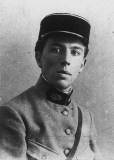
Breton the soldier
As soon as the first manifesto appeared, Breton was able to garner the support of a dozen fellow believers who were searching for a guiding spiritual light who could lead them in a revolt against institutions and philosophies that had tricked them into participating in a monstrous war. Most of these artists were ex-Dadaists who were contemptuous of logic and "good sense." Now that the war was over, they were ready to abandon Dada's nihilism and embraced the new freedom found in the unconscious nature of man. Because they were also tired of trivial, everyday existence, at Breton's beckoning, they explored automatic writing, the poetry of the magical, the world of dreams and Freud's subconscious. Above all, it was through man's unconscious mind, free from any logical restraint, that this group of artists hoped to liberate the human spirit. Their aim was to subvert citizens from their good behavior, bombard them with impolite messages, and show them the joys of anti-rational speculation.
The group discussed the works of Lautrémont, Rimbaud, and Alfred Jarry as well as the significance of the marvelous, the irrational, and the accidental in painting and poetry. In the poetry of Isidore Ducasse, the Comte de Lautrémont, an obscure 19th-century poet, they discovered revolt against tradition, the family, society, and even God himself. Furthermore, after reading Lautrémont's strange Les Chants de Maldoror, the group rallied around his description of a young man "beautiful as the chance meeting upon a dissecting table of a sewing machine and an umbrella." From this image, Breton conceived the sur-real condition as a moment of revelation in which are resolved the contradictions and oppositions of dreams and reality. The surreal moment, then, occurs when objects or ideas that do not ordinarily belong with one another coexist within the same context: "the resolution of those two seemingly contradictory states, dream and reality, in a kind of absolute reality, surreality, so to speak." Such a moment, however, is one of conflict rather than harmony and meant to throw the viewer off kilter.
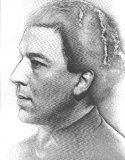
Breton the surrealist
By the fall of 1924, the Surrealists became a functioning group. At first, it was dominated by literary men who practiced automatic writing, transcribed their dreams and took part in spiritualistic sessions at which the members would speak, write or draw while under hypnosis. These writers included Louis Aragon, Arthur Crevel, Eduard Desnos, and Paul Eluard among others. As late as 1925, Breton made mention of a number of painters whose works adhered to psychic automatism, among them Max Ernst, Jean Arp, André Masson, Yves Tanguy, and even Pablo Picasso, who would never officially become part of the movement. Breton claimed that their artistic antecedents were Hieronymous Bosch's fantasy world contained in The Garden of Earthly Delights; Fransisco Goya's Los Caprichos; Guiseppe Arcimboldo's 16th-century double-image landscapes and portraits that revealed, upon examination to be made up of painted fruits and vegetables; and the work of the Italian painter Giorgio de Chirico, whose painting was primarily a means of evoking the mysteries of the unconscious. Other influences included the work of such primitive painters as Henri Rousseau, and the drawings of children and the inmates at insane asylums. Each of these latter influences were so inspiring because neither Rousseau, children, nor the insane adhered to any traditional rules in depicting whatever they felt or wanted to express. Furthermore, the Surrealists were so interested in insanity because, like primitive societies, they looked upon the insane person as one divinely inspired.

The Garden of Earthly Delights (1504-10)
When Surrealism was a young artistic movement, the surrealistic artist was judged on the basis of how well he or she evoked unconscious material. To become more familiar with the unconscious, the surrealist dabbled in drugs and hypnosis. Early on in his career, Breton and Phillipe Soupault began experimenting with automatic writing. They would lock themselves up in a dark room, tried to simulate a semi-conscious, dreamlike state of mind, and wrote down whatever words, images and sentences emerged. What Breton found invaluable about this creative act was not the end product itself, but, rather, the procedure as a means of liberating one's potential. And so, the essence of Surrealism became artlessness: the supremacy of method over product; the neglect, even the rejection of any aesthetic criteria; and the bringing of art into the sphere of everyday life. Inspired by automatic writing, by 1922 artists began to produce automatic drawings. Their drawings, however, make one wonder how automatic and unconscious they really were. These drawings suggest, rather, that unconscious doodlings were the starting point and inspiration for a more careful refinement and definition of certain figures and objects. Automatism, thus, became a means of inspiration and evocation, of calling or summoning forth images from our unconscious.
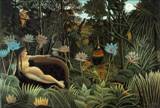
The Dream (1910)
In the early "intuitive" stage of the movement, the Surrealists loved to play another game called "exquisite corpses," which could be either verbal or visual. The verbal form of this game consisted of assigning three or more persons each the task of writing a specific unit of a sentence (subject, verb, predicate, etc.), without any of them knowing what the others had written. The game took its name from the first such sentence composed in this manner: "The exquisite / corpse / shall drink / the bubbling wine." In the visual version of this game, each artist drew something on a sheet of paper and then folded the sheet so that the next person could not see what had already been drawn. What thrilled the Surrealists so much in participating in these artistic exercises was not only chance, as much as, according to Breton, "they stood for something that couldn't possibly be the work of a single brain." Furthermore, these artistic games revealed the incongruities of the human mind that the Surrealists delighted in.
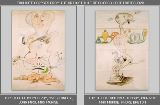
Exquisite Corpses (1928)
By 1925, the surrealist Max Ernst had discovered another means of becoming inspired and of creating the incongruous image. While visiting a seaside inn, he decided to place a sheet of paper on the wood floors and rub with a pencil. On seeing the image that he made on the paper, Ernst distinguished a "hallucinatory succession of contradictory images." After this discovery, Ernst began to experiment with a series of other materials--leaves, thread, the ragged edges of a piece of linen--and soon realized that drawings made in this way lost the character of the material used and took on a whole new appearance. This new creative effort became known as frottage, and Max Ernst collected his new images into an album of drawings that he named Natural History. Frottage, Ernst claimed, allowed him to exclude from his drawings all conscious effort and taste, and, thus, was the visual equivalent of automatic writing. Like automatic writing and drawing, frottage is based on the principle of metamorphosis, of transformation.

Conjugal Diamonds (1925)
While some Surrealists were experimenting with automatism, there were others who were exploring other possibilities of the unconscious in art. In defining Surrealism, Breton had described it as "a certain psychic automatism that comes very close to dream, a state that is very hard to circumscribe today." The second group of painters opted for exploring the dream and adopted the idea of dream-painting, based on verism or illusionism in its adherence to realism and the academic traditions of easel-painting. In other words, this group of artists applied a meticulous realism in depicting the fantastic or to familiar objects placed in unusual surroundings. But the Surrealists who chose this particular method of painting did so as a means of discovering the mysterious, the enigmatic, the unconscious. At first glance, these paintings appear to be lifelike representations of reality, but, on close inspection, there is an element of surprise in them, for the images that they portray could only exist in the human imagination or in the dream. By 1929 the automatist camp claimed the early Yves Tanguy, André Masson and Joan Miró, whereas the illusionists, as they were called. included Tanguy, René Magritte and Salvador Dali, who had all been influenced by Giorgio De Chirico and Max Ernst.
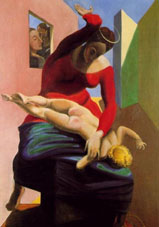
Virgin Mary Spanking the Christ Child (1926)
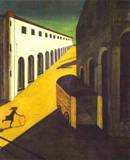
Mystery (1914)

Enigma of the Day (1914)
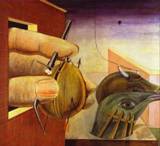
Oedipus Rex (1922)
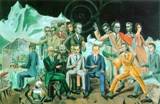
The Surrealists (1922)
19350In Paris, Max Ernst's work began to change. With the oil paintings The Elephant Celebes and Oedipus Rex, Ernst is able to further explore the themes of his collages--strange machinery, imaginary animals, objects in unstable equilibrium, a headless female body--but with a new twist. In fact, his oil paintings are loosely based on the concept of the collage in that they bring disparate realities into a new unity. In Two Children Are Threatened by a Nightingale, Ernst even included some real objects fastened to the canvas: a bell push and a little door. Ernst arranges objects to compose a dream world which is self-sufficient and valid and which lends itself to Freudian interpretations in its accidental encounters. Ernst defined his creations as "the exploitation of the chance meeting of two remote realities on a plane unsuitable to them." The objects portrayed are unreal, but the precision with which they are painted gives them the appearance of reality. In the artificial world of these paintings, things that do not exist elsewhere become real. In Woman, Old Man, and Flower and The Robing of the Bride the figures are fantastic inventions that have undergone a metamorphosis right before our very eyes. This is surrealist illusionism at its very best.
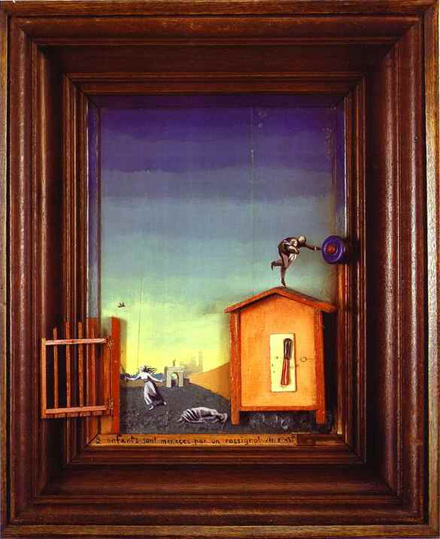
Two Children (1924)
Another Surrealist painter to come under the influence of De Chirico was the Belgian René Magritte, who proved that precise realism could be as Surrealist as pure automatism. In fact, everything that Magritte painted was a deliberate act of visual disorientation. Taking the most ordinary objects, he metamorphosized them by paying painstaking attention to naturalistic detail and then placing them outside of their normal context. In a nutshell, Magritte wanted to make the familiar strange by exploring the following principles: enlargement of a detail (an immense apple or rose filling up all the space in a room), the association of complimentaries (the chair-shelter, the bird-mountain), the animation of the inanimate (the shoe with toes, the dress with breasts), the mysterious opening, material transformations (a person who is hollow), and anatomical surprises. In each of these visual puns, the result is a mental jolt which oftentimes becomes a visual joke. In explaining his own work, Magritte has stated that "I make a point (as far as possible) of painting only pictures that evoke the mystery of all existence with the precision and charm essential to the life of thought. It seems clear that precise and charming evocations of that mystery are furnished best by images of everyday objects combined or transformed in such a way that their agreement with our preconceived ideas, simple or sophisticated, is obliterated."
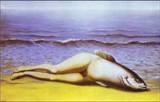
Collective Invention (1935)

This Is Not a Pipe (1935)
Perhaps no other painter has achieved as much notoriety as Salvador Dali, whose eccentricities and unconventionality have come to symbolize the very idea of Surrealism. Although Dali was a latecomer into the Surrealist circle, he epitomizes, more than any other member, everything that is irrational, erotic, insane and fashionable. To this group he brought the theory which is the basis of his paintings, his paranoiac-critical method, also based on illusionism. With this method, Dali created a visionary reality from elements of visions, dream, memories, and psychological/pathological distortions. And thus, Dali derives his definition of painting: "photography (by hand and in color) of concrete irrationality and of the imaginary world in general." In the visual realm, the paranoiac-critical method manifests itself mainly in the ability to see different objects "into" certain things in a hallucinatory fashion. For instance, in The Bust of Voltaire, if you look at the bust a second time around, you can see that the image becomes transformed into several woman entering through a threshold. In other words, through the double image Dali was striving for visual identity between two disparate objects just as Ernst and Magritte had in their own way.
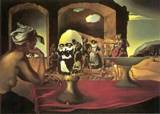
Slave Market and the Disappearing Bust of Voltaire (1940)
In his work, Dali had been influenced by several different forces. One of his own demons was the fear the impotence, as expressed in The Persistence of Memory with its melting clocks and limp figures. The painting's style is inspired by Dali's admiration for Dutch Baroque painting, miniature technique, and discordant colors. He declared that his primary images to be blood, decay, and excrement. In Accommodation of Desire, he takes a commonplace image, a lion, and sets up a chain of metamorphosis that occur right before our eyes as though we were watching a film. In Gala and the Angelus of Millet Immediately Preceding the Arrival of the Conic Anamorphose, he uses Millet's Angelus as a point of departure. In this painting, Gala, Dali's wife, sits grinning broadly in front of a male. Over the open doorway is a print of Millet's Angelus, while around the open doorway a monstrous figure emerges wearing a lobster for a hat. Of course, there is no obvious explanation for the scene, but it is, nevertheless a nightmare. It is Hieronymous Bosch's nightmarish world that has inspired Dali's Inventions of the Monsters (1938), full of double or hidden images. There is a giraffe on fire, centaurs who expose their massive buttocks, joined profiles of Dali and Gala as if to suggest Leonardo's Mona Lisa, and an altar to Venus topped with a beautiful woman whose other side of her face is a horse.
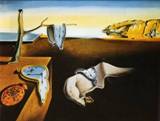
The Persistence of Memory (1931)

Gala and the Angelus (1935)
Another Spaniard from Barcelona, Joan Miró, could not have been more unlike his fellow countryman Dali. Whereas Dali's art was illusionist, Miró's method was automatist. Coming under the influence of Breton and the Surrealists after he had arrived in Paris, Miró had taken part in the production of exquisite corpses. Miró also rebelled against the entire tradition of painting, abandoning all principles of composition, spatial organization, and three-dimensional definition. In fact, Miró's works are a cheerful, witty protest against all pretentiousness in art in their minimum of significant elements and their sketchiness. Furthermore, whereas Dali's art claimed to illustrate dreams, Miró was re-creating the dream experience. In his own words: "I do not start with the idea that I will paint a certain thing. I start to paint and while I am painting the picture begins to take effect, it reveals itself. In the act of painting, a shape will begin to mean woman, or bird. . . the first stage is free, unconscious."
.jpg)
The Tilled Field (1924)
Miró had arrived in Paris in 1919 and came under the influence of several modernist movements, dabbling in fauvism, cubism and dada It was during this experimental time his paintings were grandly conceived as in The Farm, originally owned by Ernest Hemingway. But then he came under the spell of the Surrealists, and the rest is history. The shapes that started to emanate were biomorphic and portrayed abstract dream imagery. Working in a kind of frenzy that was brought on by his hunger because he had nothing to eat, Miró applied his color in thin washes and allowed it to drip down the canvas, painting so rapidly that the gesture, the act itself became the subject. Line drawings and squiggles appear to have been thrown onto the canvas hastily and aimlessly. In several paintings, written words and numbers help us give form to the subject at hand that often appears to be merely arbitrary personal impulses. The effect is fantasy producing. By 1928, Miró was no longer under the Surrealist spell. Instead, Miró concentrated more and more on abstract, flat shapes that lacked the inspirational quality of his earlier paintings. Unfortunately, he became stuck in a very personal picture language that became the content of his work. As a result, his paintings lost the element of magical surprise, and they suffered.
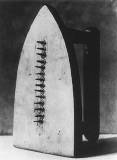
Gift (1921)
The Surrealists also imposed the object on modern art and brought it into competition with sculpture. Marcel Duchamp had popularized the ready-made, an industrially mass-produced object whose function is altered and thus dragged out of its context of automatic reproduction. The "ready-made" has been altered because it has been transformed by the artist into the receptacle of his thought, a thing of the mind. The Man Ray, the American ex-patriate living in Paris, transformed a flat-iron by gluing nails unto its surface, thus rendering it useless and naming it The Gift. Object to be Destroyed, also by Man Ray, is a metronome with a photo of an eye attached, that the artist burned in effigy of a woman who spurned him. Ironically, Man Ray photographed the object as it went up in smoke. Probably the most famous ready-made was Meret Oppenheim's Cup, Saucer and Spoon in Fur, a humble object which by the caprice of desire is rendered useless by giving it a sumptuous appearance. Each of these objects jolt us in that they bring together two or more incongruent realities that are not normally associated together in waking life. This is a surrealist moment.
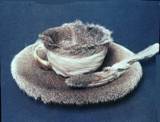
Cup, Saucer and Spoon in Fur (1936)